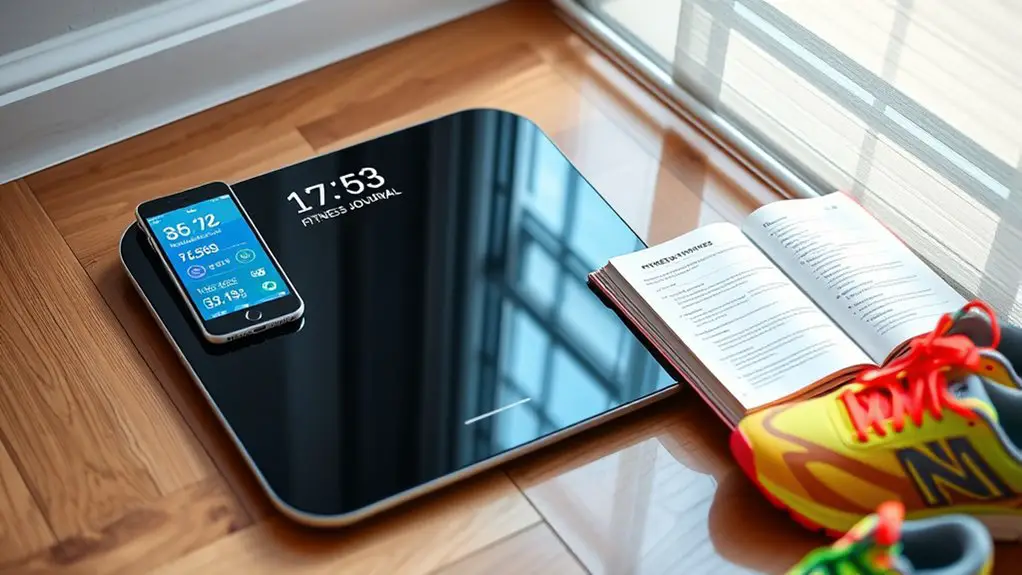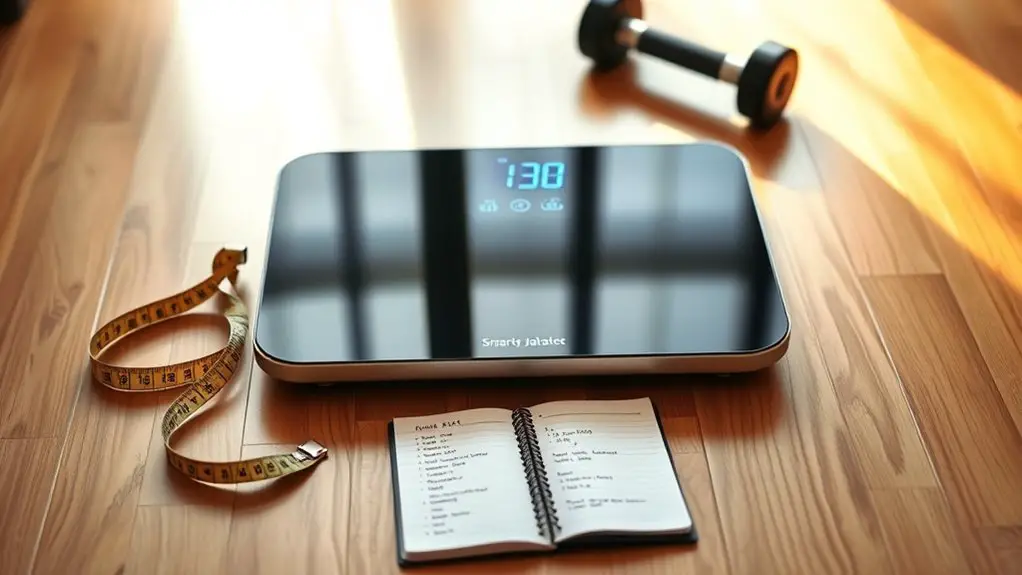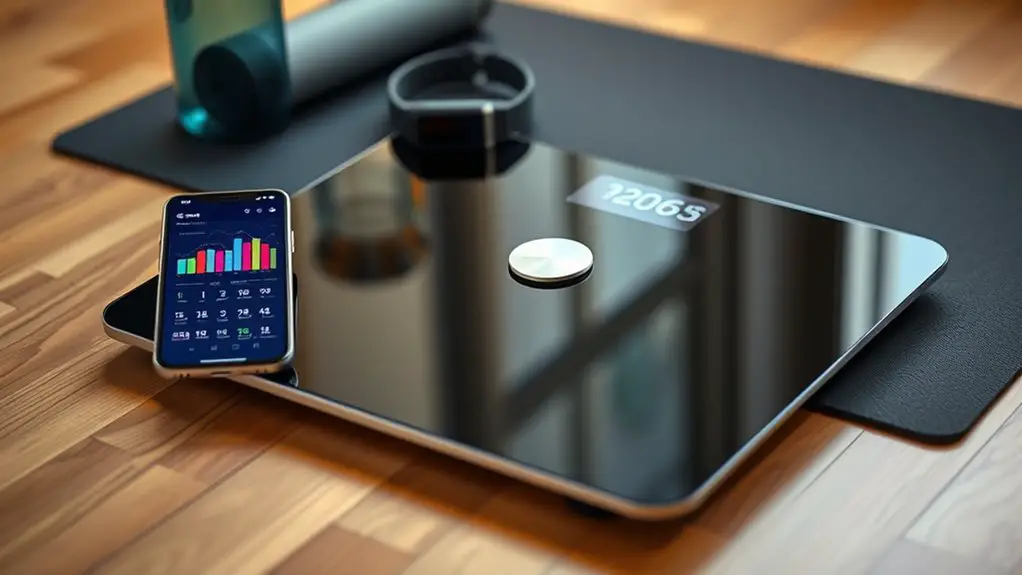How to Use Smart Scales for Gym Progress Tracking
To use smart scales for gym progress tracking, start by understanding metrics like body fat, muscle mass, and hydration. Set clear fitness goals to keep you motivated and establish a consistent weigh-in routine for accurate data. Regularly interpret your body composition results to adjust your training and nutrition accordingly. Tracking changes over time is key, and integrating your scale data with other fitness tools can enhance your progress. Explore more ways to maximize your fitness journey!
Understanding Smart Scale Metrics

When you step onto a smart scale, you might be surprised by the wealth of information it can provide beyond just your weight. These devices measure key health metrics like body fat, muscle mass, hydration level, and even bone density. Understanding these metrics gives you a clearer picture of your overall health. For instance, tracking your muscle mass can motivate you to build strength, while monitoring your body fat percentage helps you assess fat loss over time.
Also, smart scales can reveal your metabolic rate and visceral fat levels, informing you about potential health risks. It’s important to remember that weight fluctuations are normal, but focusing on these metrics can help you stay on track. By regularly checking these health metrics, you can adapt your fitness routine to align with your goals, making your journey much more effective and rewarding. Embrace this technology—it’s a powerful tool for your fitness journey!
Setting Clear Fitness Goals
Setting clear fitness goals is essential for tracking your progress effectively. Start by defining specific objectives that resonate with you, then establish measurable targets to keep you accountable. Finally, set realistic timelines to guarantee you stay motivated and on track throughout your fitness journey.
Define Specific Objectives
While pursuing your fitness journey, defining specific objectives is essential for maintaining motivation and tracking progress. Goal specificity and objective clarity help create a roadmap for your success. Here’s a simple table to guide you in establishing your fitness goals:
| Objective | Specifics | Timeframe |
|---|---|---|
| Weight Loss | Lose 10 pounds | 3 months |
| Muscle Gain | Increase muscle mass by 5% | 6 months |
| Endurance | Run 5K in under 30 minutes | 2 months |
| Flexibility | Perform a split | 4 months |
| Strength Training | Lift 200 lbs on squat | 5 months |
Establish Measurable Targets
How can you truly measure your progress without clear targets? Establishing measurable milestones is essential for tracking your gym journey effectively. By defining target metrics, you can keep your motivation high and your focus sharp. Here are some tips to help you set those targets:
- Determine your ideal weight or body fat percentage.
- Set specific strength goals, like lifting a certain weight.
- Track improvements in endurance, such as running a specific distance.
- Monitor changes in muscle mass or overall composition.
With these measurable milestones, you’ll have a clear roadmap to follow. You’ll also be able to celebrate small victories along the way, making your fitness journey not just about the destination, but about the progress you’re making every step of the way.
Set Realistic Timelines
As you begin your fitness journey, it’s essential to establish realistic timelines for your goals to guarantee steady progress without overwhelming yourself. Setting realistic expectations helps you stay motivated and focused. Break down your larger goals into achievable milestones, such as losing a certain number of pounds each month or increasing your strength by a specific percentage. This way, you can celebrate small victories along the way, which boosts your confidence and keeps you on track. Remember, progress takes time, and it’s better to pace yourself than to rush and risk burnout or injury. By setting these timelines, you not only create a clear path for your journey but also cultivate a sustainable approach to achieving your fitness aspirations.
Establishing a Consistent Weigh-In Routine
To truly track your progress with a smart scale, establishing a consistent weigh-in routine is essential. Regular weigh-ins can provide you with valuable insights and keep you motivated on your fitness journey. Here are some tips to help you create a successful routine:
- Choose a specific day and time for your weigh-ins.
- Stick to your morning routine, weighing in after using the restroom and before breakfast.
- Maintain the same weigh-in frequency, whether it’s weekly or bi-weekly.
- Record your results in a journal or app to visualize your progress.
Interpreting Body Composition Data

While it’s easy to focus solely on your weight, understanding body composition data from your smart scale can provide a more extensive view of your fitness progress. Body composition reveals the balance between your body fat and muscle mass, which is essential for evaluating your overall health. If you notice a decrease in body fat but an increase in muscle mass, that’s a sign you’re on the right track, even if your weight stays the same.
Pay attention to the percentages reported by your scale. Ideally, you want a lower body fat percentage and a higher muscle mass percentage. This balance not only enhances your appearance but also boosts your metabolism and strength. Remember, fitness is a journey, and these numbers are tools to help you stay motivated. Embrace the insights your smart scale offers to tailor your workouts and nutrition effectively. Keep pushing toward your goals!
Tracking Changes Over Time
Tracking your progress over time is key to staying motivated and adjusting your fitness journey. Smart scales provide valuable insights into your body changes, helping you navigate weight fluctuations effectively. By consistently monitoring your data, you can gain a clearer understanding of your overall health and fitness.
Tracking your progress with smart scales helps you understand your body and stay motivated on your fitness journey.
- Identify patterns in body composition over weeks and months.
- Understand how different workouts impact your weight and muscle gain.
- Recognize that fluctuations are normal and part of the process.
- Use data to set realistic goals and celebrate small victories.
Embrace the journey, and remember that every number tells a story. When you track changes over time, you’re not just counting pounds; you’re building a healthier, stronger you. Stay committed, stay curious, and let your smart scale guide you toward your fitness aspirations!
Integrating Smart Scale Data With Other Fitness Tools

To get the most out of your smart scale, consider syncing it with your favorite fitness apps. This integration allows you to analyze your body composition trends alongside your workouts and nutrition, giving you a clearer picture of your progress. By combining this data, you can set more informed goals and stay motivated on your fitness journey.
Syncing With Fitness Apps
Integrating your smart scale data with fitness apps can greatly enhance your progress tracking, as it allows for a more detailed view of your health journey. By syncing devices, you can effortlessly compile your weight, body fat percentage, and other metrics in one place. Here are some benefits of app compatibility:
- Track your workouts and nutrition alongside your body metrics.
- Set personalized goals based on extensive data.
- Receive insights and trends to keep you motivated.
- Share your progress with friends or fitness communities for added support.
Analyzing Body Composition Trends
Using smart scale data alongside other fitness tools can greatly enhance your understanding of body composition trends. By tracking changes in body fat and muscle mass, you can create a thorough picture of your fitness journey. For instance, combine your smart scale readings with workout logs and nutrition apps to see how your diet and exercise influence your body composition. If you notice a decrease in body fat but a stable weight, your muscle mass might be increasing, indicating successful strength training. Regularly analyzing this data helps you adjust your fitness regimen, stay motivated, and set realistic goals. Remember, progress isn’t just about the scale—it’s about how you feel and the improvements in your overall health.
Adjusting Your Training and Nutrition Based on Insights
While monitoring your gym progress with smart scales can be enlightening, adjusting your training and nutrition based on the insights gained is where the real transformation begins. When you see changes in your body composition, it’s essential to make proactive nutrition adjustments and training modifications to align with your goals.
- Increase protein intake to support muscle growth.
- Reduce carbohydrates if weight loss is your aim.
- Switch up your workout routine to prevent plateaus.
- Incorporate more recovery days to avoid burnout.
Additionally, tracking visible improvements in body composition can help you make informed decisions about your diet and exercise plan.
Frequently Asked Questions
Can Smart Scales Measure Hydration Levels Accurately?
Smart scales can measure hydration levels, but their accuracy can vary. Using advanced smart scale technology, these devices estimate body water percentage through bioelectrical impedance. While they provide a general idea of hydration measurement accuracy, it’s essential to remember they’re not always precise. For the best results, combine their readings with other hydration methods, and stay motivated by tracking your progress over time. Staying hydrated is key to achieving your fitness goals!
How Can I Sync My Smart Scale With My Phone?
To sync your smart scale with your phone, first check its compatibility with your device. Most smart scales connect via Bluetooth or Wi-Fi. Download the corresponding app, then follow the in-app instructions to pair your scale. Once synced, you can track your measurements easily. This app integration can motivate you by providing insights into your progress. So, take a moment to get everything connected, and watch your fitness journey unfold!
Do Smart Scales Work on All Floor Types?
Smart scales can work on various floor types, but you need to guarantee floor stability for accurate readings. Uneven or soft surfaces might throw off the scale’s calibration, leading to inconsistent results. It’s best to place your scale on a hard, flat surface like tile or hardwood for the best accuracy. By doing this, you’re setting yourself up for success in tracking your fitness journey effectively and confidently!
Are Smart Scales Safe for Everyone to Use?
Imagine stepping onto a sleek, modern scale that lights up like a dashboard, ready to help you track your progress. Smart scales are generally safe for everyone, but there are safety concerns you should consider. Always follow user guidelines, especially if you have medical conditions like pacemakers. If you’re unsure, consult a healthcare professional. Embrace the journey toward better health, armed with knowledge and the right tools to measure your success.
How Often Should I Replace My Smart Scale?
You should consider replacing your smart scale every 3 to 5 years, depending on its lifespan and performance. If you notice inconsistencies in readings or if it starts malfunctioning, it might be time for a replacement. Keeping track of scale replacement frequency helps guarantee you’re getting accurate data, which is essential for your fitness goals. Staying motivated and informed about your progress is key, so don’t hesitate to invest in a reliable device!





